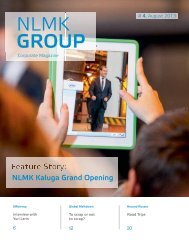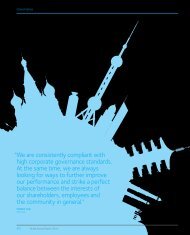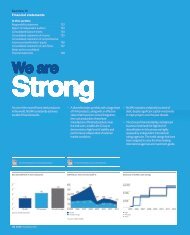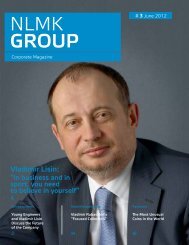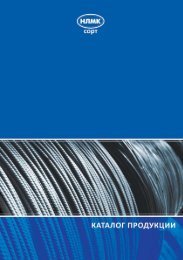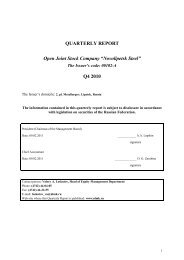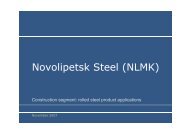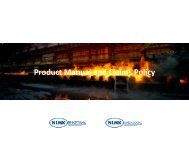Notes to the consolidated financial statements - NLMK Group
Notes to the consolidated financial statements - NLMK Group
Notes to the consolidated financial statements - NLMK Group
You also want an ePaper? Increase the reach of your titles
YUMPU automatically turns print PDFs into web optimized ePapers that Google loves.
Glossary<br />
TECHNOLOGY<br />
Cold-Rolling<br />
Changes in <strong>the</strong> structure and shape of steel achieved through<br />
rolling <strong>the</strong> steel at a low temperature (often room temperature).<br />
It is used <strong>to</strong> create a permanent increase in <strong>the</strong> hardness and<br />
strength of <strong>the</strong> steel. It is effected by <strong>the</strong> application of forces<br />
<strong>to</strong> <strong>the</strong> steel which causes change in <strong>the</strong> composition, enhancing<br />
certain properties. In order for <strong>the</strong>se improvements <strong>to</strong> be<br />
sustained, <strong>the</strong> temperature must be below a certain range<br />
because <strong>the</strong> structural changes in <strong>the</strong> steel are eliminated by<br />
higher temperatures.<br />
Hot-Rolling<br />
The rolling process of a hot slab reducing in<strong>to</strong> a coil of specified<br />
thickness at a relatively high temperature.<br />
Continuous Casting<br />
Process of continuous production of billets or slabs from liquid<br />
steel that is poured in<strong>to</strong> a cast or mold.<br />
Blast Furnace<br />
Facility for converting prepared iron ore in<strong>to</strong> liquid iron (pig iron).<br />
It works on <strong>the</strong> counter flow principle: <strong>the</strong> charge (consisting of<br />
ore, burden, additives and coke) is introduced from <strong>the</strong> <strong>to</strong>p –<br />
usually via a rotary chute. The hot blast flows in <strong>the</strong> opposite<br />
direction. The blast is pre-heated in s<strong>to</strong>ves and injected in<strong>to</strong><br />
<strong>the</strong> furnace through tuyeres. Coke is used as reduction agent.<br />
Depending on charge and method of operation, different types<br />
of pig iron and even ferroalloys can be produced. A blast furnace<br />
remains in operation for many years (furnace campaign). The<br />
performance and cost efficiency of a blast furnace can be<br />
increased by larger furnace units, au<strong>to</strong>matic charging, burden<br />
preparation, high blast temperatures, oxygen injection in <strong>the</strong><br />
blast and pressurised charging. Blast furnace byproducts are<br />
blast furnace gas and blast furnace slag.<br />
Basic Oxygen Furnace/Converter<br />
In <strong>the</strong> basic oxygen furnace molten iron is made in<strong>to</strong> steel.<br />
Oxygen is injected <strong>to</strong> drive out carbon and o<strong>the</strong>r impurities<br />
dissolved in <strong>the</strong> melt. This process generates a lot of heat,<br />
so that recycled steel is added <strong>to</strong> keep <strong>the</strong> melt at around<br />
1700°C. The resulting crude steel is ei<strong>the</strong>r fur<strong>the</strong>r purified<br />
or alloyed in subsequent secondary metallurgy processes,<br />
or directly brought <strong>to</strong> <strong>the</strong> casting process.<br />
Electric Arc Furnace (EAF)<br />
A method of producing steel through <strong>the</strong> melting of recycled<br />
steel and o<strong>the</strong>r sources of iron using electricity.<br />
Ladle Furnace<br />
The facility used <strong>to</strong> maintain <strong>the</strong> temperature of liquid steel<br />
during processing after tapping from <strong>the</strong> scrap-melting furnace.<br />
This also allows <strong>the</strong> molten steel <strong>to</strong> be kept ready for use<br />
in <strong>the</strong> event of a delay later in <strong>the</strong> steel-making process. The<br />
ladle furnace consists of only <strong>the</strong> refrac<strong>to</strong>ry roof and electrode<br />
system of a scrap-melting furnace, but it has no need for a<br />
tilting mechanism or scrap charging.<br />
Reversing Mill<br />
Mill stand which forms material as it reciprocates between<br />
adjustable rolls. Consists of one or two stands, at least one<br />
of which carries out several reversing passes.<br />
Pickling<br />
Removing surface oxides from metals by a chemical reaction.<br />
Hot-Dip Galvanizing<br />
A galvanizing process whereby steel is dipped in<strong>to</strong> molten<br />
metal. The process can be performed continuously (by running<br />
steel strip through <strong>the</strong> molten metal) or in batches (by dipping<br />
complete products such as au<strong>to</strong>mobile bodies or gates in<strong>to</strong> a<br />
metal bath).<br />
PRODUCTS AND RAW MATERIALS<br />
Alloy<br />
A metal that consists of a<strong>to</strong>ms of more than one element.<br />
Changing composition and microstructure of alloys enables<br />
<strong>the</strong> targeted engineering of desired material properties.<br />
Slab<br />
Compact block of crude steel, product of <strong>the</strong> casting process<br />
in <strong>the</strong> melt shop, used as a starting material in <strong>the</strong> rolling mills<br />
<strong>to</strong> produce hot strip.<br />
Electrical Steel<br />
A type of steel that exhibits specific magnetic properties, which<br />
are required <strong>to</strong> make transformers, power genera<strong>to</strong>rs and<br />
electric mo<strong>to</strong>rs. It is mainly obtained by alloying with silicon.<br />
Coke<br />
The basic fuel consumed in blast furnaces in <strong>the</strong> smelting of<br />
iron. Coke is a processed form of coal.<br />
Iron Ore Concentrate<br />
Iron ore containing <strong>the</strong> valuable minerals of an ore from which most<br />
of <strong>the</strong> waste material has been removed by undergoing treatment.<br />
Sinter Ore<br />
Product of combining iron-bearing particles under high<br />
temperature in<strong>to</strong> small chunks with aim of conserving <strong>the</strong><br />
iron for blast furnace process.<br />
Pellets<br />
An enriched form of iron ore shaped in<strong>to</strong> small balls or pellets.<br />
Pellets are used as a raw material in <strong>the</strong> steel-making process.<br />
Scrap (Ferrous)<br />
Ferrous (iron-containing) material that is generally remelted<br />
and recast in<strong>to</strong> new steel in electric arc furnaces. Integrated<br />
steel mills also use scrap for up <strong>to</strong> 25% of <strong>the</strong>ir basic oxygen<br />
furnace charge. Scrap is wasted steel, prepared for recycling.<br />
Pig Iron<br />
An alloy of iron and carbon that is produced in a blast furnace.<br />
Crude Steel<br />
Steel in primary form of hot molten metal.<br />
Billet<br />
A semi-finished steel form that is used for steel long products<br />
such as bars, channels, wire rod or o<strong>the</strong>r structural shapes.<br />
Rebar (Reinforcement Bar)<br />
A commodity-grade steel used <strong>to</strong> streng<strong>the</strong>n concrete in highway<br />
and building construction.<br />
Wire Rod<br />
Round, thin, semi-finished steel length that is rolled from a<br />
billet and coiled for fur<strong>the</strong>r processing. Wire rod is commonly<br />
drawn in<strong>to</strong> wire products or used <strong>to</strong> make bolts and nails.<br />
Hot-Rolled Steel (HR, HRC)<br />
Product that is sold in its ‘as-produced’ state off <strong>the</strong> hot-rolling<br />
mill with no fur<strong>the</strong>r reduction or processing steps, aside from<br />
being pickled and oiled (if specified).<br />
Cold-Rolled Steel (CR,CRC)<br />
Steel that is rolled at common or low temperature. This kind of<br />
steel has increased hardness and strength.<br />
<strong>NLMK</strong> ANNUAL REPORT 2008 111



